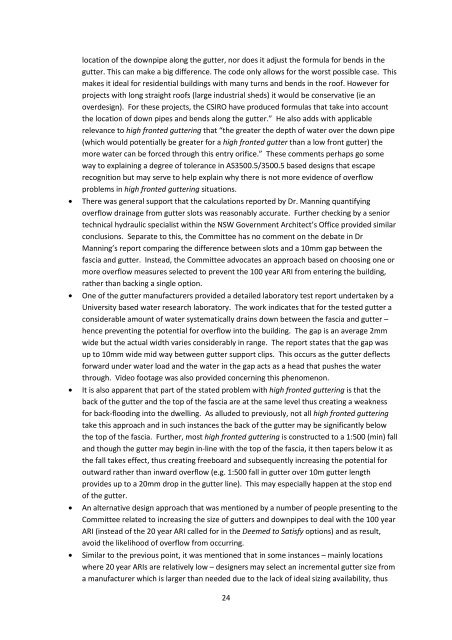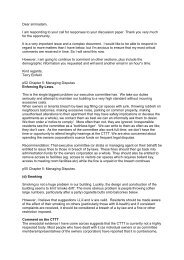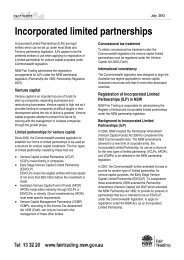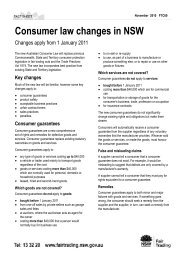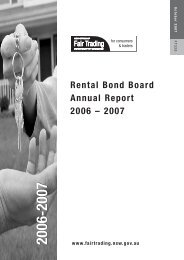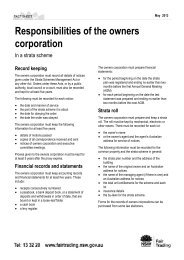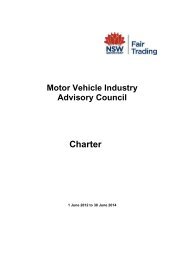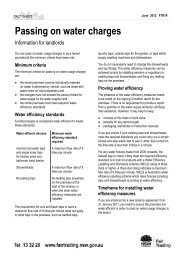High front guttering advisory committee report - NSW Fair Trading ...
High front guttering advisory committee report - NSW Fair Trading ...
High front guttering advisory committee report - NSW Fair Trading ...
You also want an ePaper? Increase the reach of your titles
YUMPU automatically turns print PDFs into web optimized ePapers that Google loves.
location of the downpipe along the gutter, nor does it adjust the formula for bends in the<br />
gutter. This can make a big difference. The code only allows for the worst possible case. This<br />
makes it ideal for residential buildings with many turns and bends in the roof. However for<br />
projects with long straight roofs (large industrial sheds) it would be conservative (ie an<br />
overdesign). For these projects, the CSIRO have produced formulas that take into account<br />
the location of down pipes and bends along the gutter.” He also adds with applicable<br />
relevance to high <strong>front</strong>ed <strong>guttering</strong> that “the greater the depth of water over the down pipe<br />
(which would potentially be greater for a high <strong>front</strong>ed gutter than a low <strong>front</strong> gutter) the<br />
more water can be forced through this entry orifice.” These comments perhaps go some<br />
way to explaining a degree of tolerance in AS3500.5/3500.5 based designs that escape<br />
recognition but may serve to help explain why there is not more evidence of overflow<br />
problems in high <strong>front</strong>ed <strong>guttering</strong> situations.<br />
• There was general support that the calculations <strong>report</strong>ed by Dr. Manning quantifying<br />
overflow drainage from gutter slots was reasonably accurate. Further checking by a senior<br />
technical hydraulic specialist within the <strong>NSW</strong> Government Architect’s Office provided similar<br />
conclusions. Separate to this, the Committee has no comment on the debate in Dr<br />
Manning’s <strong>report</strong> comparing the difference between slots and a 10mm gap between the<br />
fascia and gutter. Instead, the Committee advocates an approach based on choosing one or<br />
more overflow measures selected to prevent the 100 year ARI from entering the building,<br />
rather than backing a single option.<br />
• One of the gutter manufacturers provided a detailed laboratory test <strong>report</strong> undertaken by a<br />
University based water research laboratory. The work indicates that for the tested gutter a<br />
considerable amount of water systematically drains down between the fascia and gutter –<br />
hence preventing the potential for overflow into the building. The gap is an average 2mm<br />
wide but the actual width varies considerably in range. The <strong>report</strong> states that the gap was<br />
up to 10mm wide mid way between gutter support clips. This occurs as the gutter deflects<br />
forward under water load and the water in the gap acts as a head that pushes the water<br />
through. Video footage was also provided concerning this phenomenon.<br />
• It is also apparent that part of the stated problem with high <strong>front</strong>ed <strong>guttering</strong> is that the<br />
back of the gutter and the top of the fascia are at the same level thus creating a weakness<br />
for back-flooding into the dwelling. As alluded to previously, not all high <strong>front</strong>ed <strong>guttering</strong><br />
take this approach and in such instances the back of the gutter may be significantly below<br />
the top of the fascia. Further, most high <strong>front</strong>ed <strong>guttering</strong> is constructed to a 1:500 (min) fall<br />
and though the gutter may begin in-line with the top of the fascia, it then tapers below it as<br />
the fall takes effect, thus creating freeboard and subsequently increasing the potential for<br />
outward rather than inward overflow (e.g. 1:500 fall in gutter over 10m gutter length<br />
provides up to a 20mm drop in the gutter line). This may especially happen at the stop end<br />
of the gutter.<br />
• An alternative design approach that was mentioned by a number of people presenting to the<br />
Committee related to increasing the size of gutters and downpipes to deal with the 100 year<br />
ARI (instead of the 20 year ARI called for in the Deemed to Satisfy options) and as result,<br />
avoid the likelihood of overflow from occurring.<br />
• Similar to the previous point, it was mentioned that in some instances – mainly locations<br />
where 20 year ARIs are relatively low – designers may select an incremental gutter size from<br />
a manufacturer which is larger than needed due to the lack of ideal sizing availability, thus<br />
24


